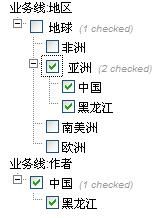Struts2 Map嵌套List实现
最近一直在研究struts2,看了sturts2和博客的相关文章,学习了Struts2 Map嵌套List实现,下面是是示例演示:
过程:
1.页面前一个Action中实现ServletRequestAware接口
2.在Action中将serviceTypesCategories 放入request中
private Map<String, List<Category>> serviceTypesCategories = new HashMap<String, List<Category>>();
request.setAttribute("serviceTypesCategories", serviceTypesCategories);
3.JSP页面代码
<s:iterator value="%{serviceTypesCategories.keySet()}" id="serviceTypeString" >
<s:set name="serviceTypeRequest" scope="request" value="#serviceTypeString"/>
<s:text name="preferential_servicestype"/>:<s:property value="serviceTypeString"/><br>
<%
Map<String, List<Category>> serviceTypesCategories = (Map<String, List<Category>>) request
.getAttribute("serviceTypesCategories");
String servicetype = (String) request.getAttribute("serviceTypeRequest");
PreferentialCheckTreeUtil util = new PreferentialCheckTreeUtil();
List<Category> myCategories = serviceTypesCategories.get(servicetype);
List<Category> rootCategories = new ArrayList<Category>();
out.println(" <script language=\"JavaScript\">");
out.println("var check" + treeIndex + " = new CheckTree('check" + treeIndex + "');");
out.println("</script>");
out.println(" <ul id=\"tree-check" + treeIndex + "\" class=\"checktree\">");
for (Category category : myCategories) {
if (category.getLevel() == 1) {
rootCategories.add(category);
}
}
final PrintWriter mcpsOut = response.getWriter();
for (Category rootCategory : rootCategories) {
// out.println(rootCategory.getName());
//判定是否是当前层的最后一个节点
if (rootCategory.getId() == rootCategories.get(rootCategories.size() - 1).getId()) {
util.printCategoryWithCheck(rootCategory, out, true);
}
else {
util.printCategoryWithCheck(rootCategory, out, false);
}
}
out.println("</ul>");
treeIndex++;
%>
</s:iterator>
注意:这里使用了<S:SET/>标签,并且设置scope为request,如果不放入request中,会出现页面偶尔显示不出来的情况,
原因是: <s:iterator value="%{serviceTypesCategories.keySet()}" id="serviceTypeString" >
默将serviceTypeString放入stack context中,并非reqeust中.
